I remember the day my path diverged dramatically. From a seasoned engineer, I found myself captivated by the nuances of stringed instruments, especially guitars. The world of lutherie, the craft of constructing and repairing guitars, unraveled before me. Yet it was the artistry of wood burned guitars, a technique known as pyrography, that kindled my true passion. These are personalized guitars, detailed with exquisite designs through the careful application of heat.
Over twenty-five years in this field, I’ve seen firsthand the transformational role pyrography can have – not just aesthetically, but impacting the overall sound and feel of the instrument as well. Preserving the essence of the guitar, yet augmenting its character, these guitars are more than mere instruments; they become intimate expressions of the player’s unique persona and style.
Now, I invite you on a journey. Let’s explore the fascinating realm of wood burned guitars, from the intricate styles and options available to the influential impact of wood burning on a guitar’s sound. Together, we’ll delve deep into the art and science of these spectacular pieces of functional art.
What are Wood Burned Guitars
Acoustic vs Electric
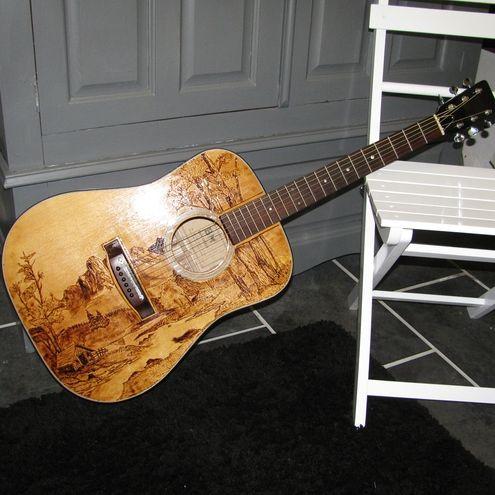
As we delve further into the intricacies of wood burned guitars, understanding the various implications between an acoustic guitar and an electric guitar becomes instrumental. Each type offers unique virtues; they function as distinct canvases for lichenburg burning on guitars, thereby reflecting various nuances of this art form.
As someone who has designed and built both types, I have come to realize the individualistic beauty of the acoustic and electric guitars. Each unravels a different story – one that is inseparably connected to the guitarist’s persona. For instance, an acoustic guitar, with its solid wooden surface, produces a raw, vibrant burn, evoking an air of natural charm. Such an organic edge characterizes the lichenburg burns on acoustic guitars, imbuing a warm, earthy touch to the overall aesthetic appeal.
On the other hand, the electric guitar plays host to an entirely contrasting persona. They flaunt a slicker and more polished appeal even after the burning process. The burns generated on their synthetic surfaces are edgier and appear more defined. Considering their more contemporary prevalence, electric guitars tend to project an avant-garde appeal with their contrasting aesthetics of modernity and age-old wood burning artistry.
Moving ahead, we will broaden our exploration into a myriad of attributes that define these fascinating, wood-burned instruments. This understanding sheds light on what makes these guitars not just any musical instrument, but works of art, where traditional and modern elements harmoniously fuse. The significance and effects of acoustic versus electric characteristics contribute substantially towards the comprehensive understanding of wood burned guitars.
Defining the Guitars’ Type and Art
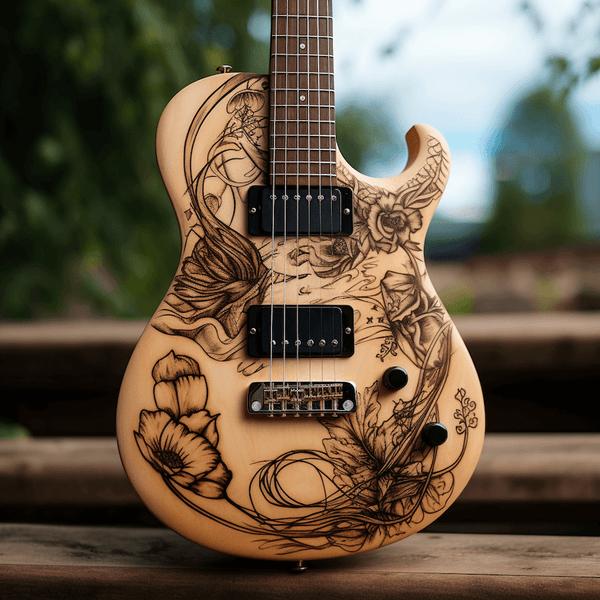
As we delve deeper into the subject of wood burned guitars, it’s essential to understand the significant role guitar design plays in this medium. Being a fervent enthusiast for guitar art and customization, I’ve always found joy in exploring unique and personalized guitar designs. This creative process grants the liberty to define distinctive identities for each instrument, transforming them into playable pieces of art.
In the world of guitar art, the canvas isn’t restricted to just custom guitar bodies. Both acoustic and electric guitars, with their diverse external architecture, pose as blank slates for artistic exploration. The relevance of either type of guitar depends on the artist’s preference and the intricacies of the design process. Whether the choice is a delicate, traditional design on the wide body of an acoustic, or a bold, distinctive etching on the narrow form of an electric guitar, the possibilities for visual ingenuity on both platforms are limitless.
It’s important to underscore that the relationship between the artist and the instrument is a symbiotic one. The guitar design should not only pay homage to the musician’s personal style but should also adhere to the functionality and integrity of the instrument. For example, when designing a custom guitar body, care must be taken to preserve its playability while letting the artistry shine. A balanced combination of practical engineering and artistic vision is essential to creating a truly memorable wood burned guitar.
As we continue to navigate the creative universe of wood-burned guitars, it’s worth appreciating the uniqueness and individuality these instruments carry. Each design tells a story, communicates an emotion, or symbolizes a concept that resonates with the artist and the player. And I can confidently say, that is where the beauty of wood burned guitars truly manifests.
Where to Find Wood Burned Guitars
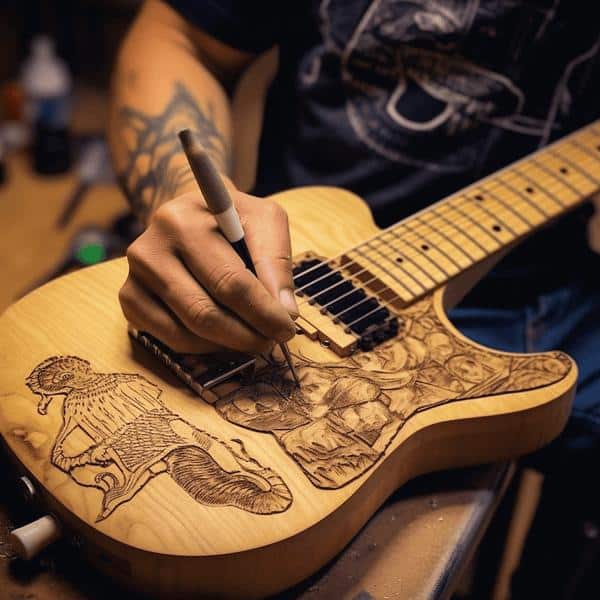
As an avid guitar collector and enthusiast, I’ve become an expert at scouting out beautiful, rare guitars. These boutique instruments tell such rich stories, the wood-burned ones are like an anthology of tales inlayed into their bodies. Yet, my search leads me not only to boutique guitar shops but also to thrift stores, places you might have never thought of associating with musical instruments.
What if the next piece of art was not in a museum but at your local thrift store or boutique guitar shop? Doesn’t that add an exciting dimension to your search for a unique guitar? Ready to embark on this unique hunt with me?
Wood-burned guitars are comparatively less common to find; their rarity makes them a treasured possession for guitar collectors like me. Sure, you can roam around various hip and happening places to land on a piece of wooden artistry. Boutique guitar shops are often the first destinations for anyone looking for such unique creations.
However, with time, I’ve discovered that searching for a wood-burned guitar is not just about walking into a fancy guitar shop; it’s more of an adventurous quest. We all know thrift stores as a treasure trove of vintage clothing, old records and quirky home decor. But if you dig deeper, you may just spot some thrift store guitar art, a term that binds the love for music and artistry together. Each piece is a testament to the skill of the luthier, the craftsman behind these intricately designed guitars. These instruments are often much older, with a history you can trace back to the burn marks and the slightest dents, marks that give each guitar its unique voice, its quintessential character.
Just like how a seemingly uninteresting thrift store can host a beautifully decorated guitar, the journey to find such a guitar is about letting your curiosity drive you. It’s about exploring and observing. Each wood-burned guitar is different, each has its unique story; finding them is like discovering a hidden gem.
So, whether you’re hunting in a family-run boutique guitar shop or rummaging through a crowded thrift store, remember, an exquisite piece of guitar art could be waiting just around the corner. If you’re fortunate enough, one of these days, amidst that hunt, you’ll hear a wood-burned guitar singing, pulling you towards it, reaching out to be picked, strummed, and cherished by you.
Why Choose a Wood Burned Guitar
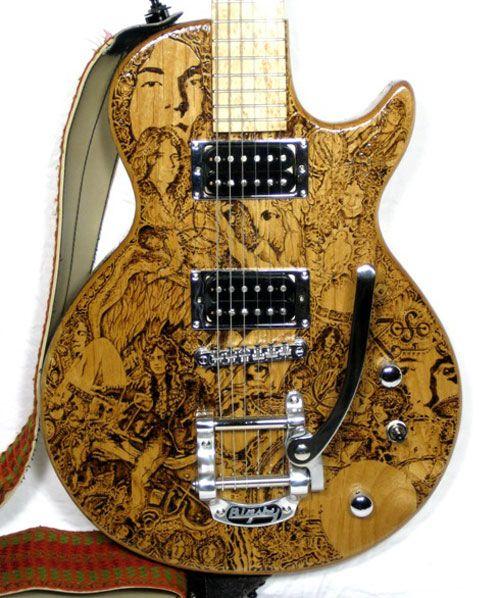
There’s a certain bright spot of wonder when you find yourself considering personalized guitars, exploring the realm of guitar customizing, and harnessing the full potential of instrument customization. This undeniable allure is what draws many to the tradition of wood-burned guitars, creating an artistic avenue through which musicians can express their unique identities.
Imagine this: You’ve picked up your guitar – not just any guitar, but a guitar that’s a reflection of yourself. The familiar resonance, the distinct melody, complemented with a design that’s woven with your narrative. This guitar is not just an instrument you play, but it’s a part of who you are – a personal testament to your musical journey.
A wood-burned guitar carries a bit of your soul within its timbered enclave. It’s a matchless experience, both humbling and exhilarating. How does playing on an instrument that’s a reflection of your personality feel? Could it transform your relationship with music?
In my years of crafting and playing my own wood-burned guitars, I’ve unearthed a richness I didn’t know was possible. Each strum, each note, carries with it an emotional connection, a quiet nakedness that is at once intimidating and irresistibly expressive.
To put it simply, a wood-burned guitar goes beyond a tool of music; it’s a narrative, a canvas of self-expression that cultivates a deep connection with your inner artist. The satisfaction it gives is a truly unique emotion. You’re not merely holding an instrument, you’re embracing a piece of art- one that is intricately designed by you and for you.
A silhouette of your uniqueness etched on your musical partner brings about an essential transformation. They’re personalized, intimate, and compellingly beautiful. You are not merely playing notes, rather, you’re weaving stories, rhythm, and raw authenticity in a harmony that only a wood-burned guitar can translate.
The joy of performing with a wood-burned guitar is indescribable. It instills a sense of camaraderie between instrument and musician. There’s a certain warmth in burnt wood, a welcomed familiarity to the scent, reminiscent of campfires and the stillness of forests. A wood-burned guitar invites nature into your music, enhancing its tone with a resonating earthiness. It’s a reminder of the world outside, a bond between the musician and the environment, and the role we all play in preserving it.
Without a doubt, the choice of a wood-burned guitar is a personal one. However, when made, it leads to a rewarding journey of deep connection with your music, your instrument, and importantly, your authentic self. This unique blend of artistry and music is not just about playing guitar. It’s about expressing yourself, unfiltered and confident, in the grand language of music.
How to Get Your Own Wood Burned Guitar
Creating Your Design
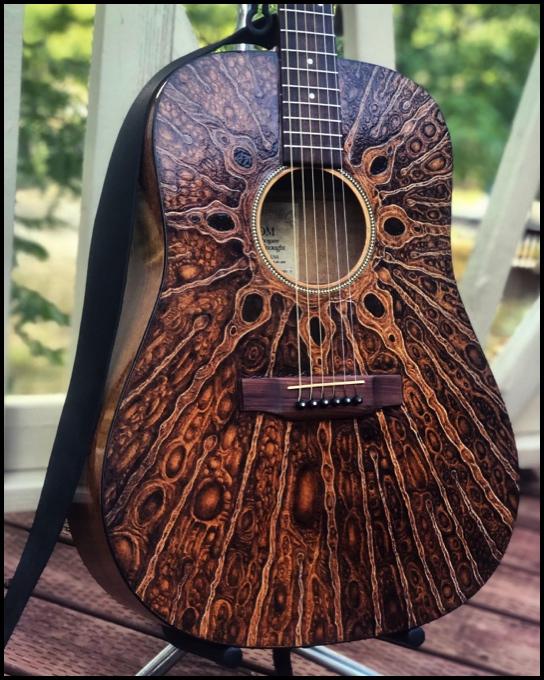
In the realm of lutherie, the creation of a unique guitar design is an exquisite blend of art and science. The wood burning impact on sound is a fundamental aspect to keep in mind during this exciting journey. As someone who has grappled with various methodologies, I can say that introducing a high-voltage wood burn technique can significantly elevate your design.
To commence, sketch out your design on the guitar – be it an intricate pattern, a vivid scene, or a simple personal insignia. This is your canvas, embellishing it should be a reflection of your personality.
Next, it’s crucial to ensure that the wood burning complements the quality of sound your guitar caters. I believe your design should enhance the aesthetic without compromising on performance, as in lutherie, it’s essential to strike a well-balanced chord of visual appeal and melody.
Then, delve into the high-voltage wood burn. This process, for the uninitiated, can create fascinating fractal designs, as if lightning were captured in the wood itself. A handy trick I’ve learned over the years is to play around with the voltage settings to create a variety of burn patterns – a testament to its versatility.
Your journey in crafting a wood burned guitar is not only a creative exploration but a meaningful endeavor that broadens your understanding of sound, design, and lutherie craft. So, take your time, put your heart into it and the results shall be a resilient testimony of your individuality.
Finding a High-Quality Burn
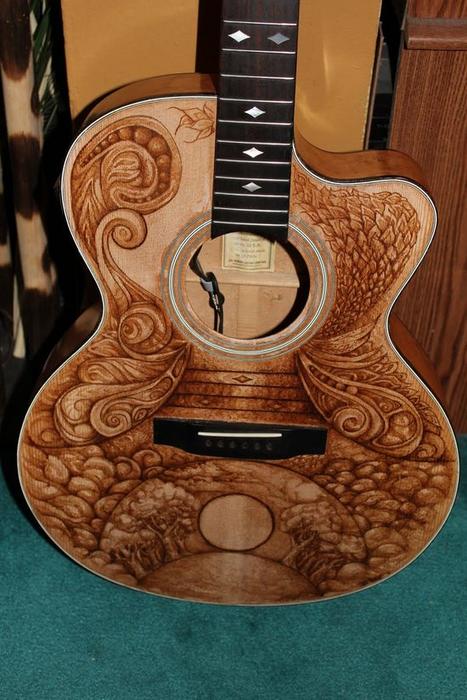
Transitioning from creating your design, one cannot underscore enough the importance of a high-quality wood burn in achieving a superb wood burned guitar. My extensive research and experimentation in the domain of stringed instruments have solidified this conviction.
A high-quality burn exudes the beauty of sophistication and rustic charm, hitting the sweet spot between art and science. It binds the design with the guitar, accentuating the craftsmanship while preserving the natural resonating beauty of the wood.
One intriguing method I’ve explored is fractal burn. It involves harnessing electricity to create stunning, tree-like patterns, resulting in a unique combination of art and physics that renders each guitar unrepeatable in its design. A masterfully executed fractal burn adds a distinctive character to the guitar, making each piece a true work of art, and contributing significantly to the personalization of your instrument.
However, considering the complexity and risks involved in fractal burning, one should only entrust an experienced professional to carry it out. Remember, it’s not just the aesthetic aspects that matter but the impact it has on the guitar’s tonal quality too.
In finding a seasoned guitar maker, you’re not only investing in a beautiful design but in an instrument that sounds just as good as it looks. As we transition into exploring the impact of wood burning on the guitar’s sound, remember that the quality of the burn is a vital component in influencing the resonance and tone of your guitar, making it truly yours.
Impact of Wood Burning on the Guitar’s Sound
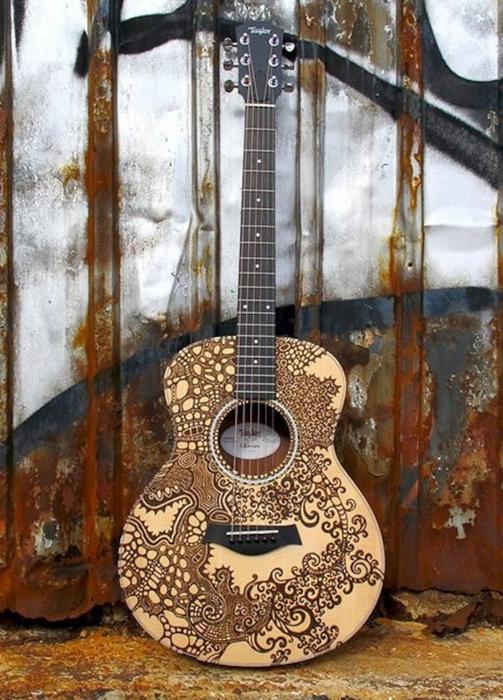
Following the origins and defining the artistry behind wood burned guitars, it seems an inevitability to delve more deeply into the aspects of my research that have intrigued me the most – the tangible changes in the guitar’s acoustics with every touch of the pyrography pen. Intricately linked to the type of guitar and design intricacies, the complexity of the topic triggers an exciting challenge to uncover various layers of impact, and in my journey, every new burn I’ve researched feels like a fresh sound discovered.
Can the flame from the pyrography pen sing a melody as captivating as the guitar strings? Uncover the astonishing impact of wood burning on a guitar’s sound. Yes, as a researcher and guitar enthusiast, I found the concept of altering the guitar’s voice through burning as fascinating as it was captivating. However, before I delve into my experiences, let’s touch the surface of the interaction between wood burning and sound.
As you might know, the wood’s density influences an acoustic guitar’s sound significantly. In the world of electric guitars, however, the impact is far more nuanced. The wood burn indeed appears to affect the tonal characteristics of an acoustic guitar more directly. In electric guitars, the effect is likely to be more subtle, influenced inherently by electronics and amplification though therein lay some remarkable anticlines waiting to be exposed.
Now, the key question that formed the crux of my research – how does the physical transformation from a burn impact the sound produced? The heat of the pyrography pen causes wood cells to expand, change the density, and inevitably alter the vibrational properties of the wood– a vital process contributing to a guitar’s sound character.
The journey to discovering these nuances has not been linear, and much like the chords on a guitar, the results of my research were layered, complex, and profoundly beautiful. The allure lies in the delicate balance, understanding just how much of an impact each burn can have on sound, without overpowering the inherent tone of the guitar.
Each wood burned guitar is unique, not merely for its aesthetic allure but also for its distinct sound – much like a musical note turned into a visual narrative through fire. In this symphony of sound and flame, a captivating melody is fashioned — a testament to the transformative power of pyrography on guitars’ tone and character.
As we progress further into the themes of where to find and why choose a wood burned guitar, the elemental understanding of how a burn shapes a guitar’s sound would provide valuable insights. Allow me to take you deeper into the reverberating world of wood-burned guitars, unraveling their stories one burn at a time.
FAQs
What is a Wood Burned Guitar?
How does the wood burning process impact the sound of the guitar?
Are there any famous musicians known for using wood burned guitars?
Can I customize my own design for a wood burned guitar?
Conclusion
Our exploration certainly brings us to understand that the artistry and impact of a wood burned guitar is far more than just a dazzling design. This intricate art form produces captivating designs that add a unique personal touch, turning the ordinary acoustic guitar into a custom masterpiece. But, the magic doesn’t stop at aesthetic beauty. Remember, wood burning also impacts the acoustic qualities, enriching the sound and broadening the instrument’s tonal palette.
As our exploration ends, do you feel the burning desire to own or create a wood burned guitar? Join me in this continuous journey of discovering fascinating sounds and designs, immersing in the world of luthiers that’s as enriching as it’s complex.
Choosing a wood burned guitar adds a distinct dimension to your musical journey. I know from my personal journey in lutherie that creating or selecting your own wood burned guitar is a pursuit that not only enhances your musical repertoire but also elucidates your own identity. Remember, it’s not just about buying a guitar; it’s about creating, finding, and defining your unique sound.
This is an engaging realm, beautiful and complex, and I encourage you to dive in. Take a plunge into this craft and feel the exhilarating joy of expressing your individuality through the enchanting and sonorous strains of a unique guitar.
